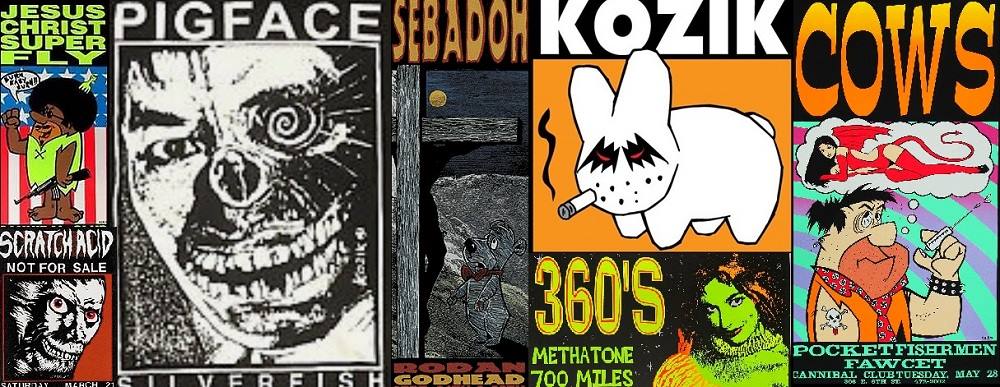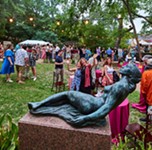Frank Kozik (1962-2023), the Man Behind a Poster Revolution
How Austin shaped the punk artist behind print mania
By Richard Whittaker, 3:30PM, Fri. May 12, 2023

When Frank Kozik passed away this week at the age of 61, he was remembered as the founding father of the modern art print scene. Chronicle writer and punk historian Tim Stegall called him "the graphic and aesthetic conscience of our generation," and that conscience will forever be associated with Austin.
Kozik was arguably the defining artist of '90s punk/indie/alt rock poster and cover art, his sleazoid sensibilities luring unwitting audiences into waves of noise and delicious depravity. The Offspring vocalist Dexter Holland (the band having hired Kozik to create the sleeve for their 1998 album, Americana) described his style as "very glossy, innocent and 1950s, but with a twisted aspect."
Kozik didn't invent the gig poster, nor was he the first Austin artist to make their reputation from them, but he was the instigator of a movement in the early 1990s that resurrected it – both visually and as a commercial enterprise. Nakatomi Inc. founder Tim Doyle said, "It made hand-made art something you could afford, because it was screenprinted, not one-offs."
Kozik was born in Madrid, Spain in 1962 during the Franco regime. "It was a fascist country," he told future Chronicle music editor Raoul Hernandez in 1997, and fascist symbolism became a part of his later art – thoroughly satirized and lampooned in bawdy fashion, a melding of the high-minded collages of Dead Kennedys go-to artist Winston Smith and underground 80s sleaze comix like Cherry Poptart. His mother came from Spanish aristocracy, his father was a US serviceman, and in 1976 this military brat was relocated to California. He soon dropped out of high school, signed up for the USAF, and dropped into the middle of Austin's burgeoning alternative and punk scene when he was stationed at Bergstrom Air Force Base (now the city's airport).
Kozik became a fixture at Club Foot, which he described as a mixture of "gays, New Wave people, leftover Cosmic Cowboy guys, these weird punk people." Eager to be part of the scene but musically incompetent ("I tried, I sucked,” he told the Chronicle in a 2013 email) and with the patronage of booker and club owner Brad First, he started making hand-bills for local acts like the Butthole Surfers and Scratch Acid. Stegall said, "When he was the doorman at the Cannibal Club, that was the first anyone realized this guy was an artist. It was all Xerox stuff, but his stuff was wild, and it just got wilder when he moved into the silk screen stuff."
That was in 1991: Kozik was sharing studio space with legendary Austin poster artists like Micael Priest and Guy Juke when a California-based art cartel paid to set up a silkscreen press for Kozik. His first work was for industrial supergroup Pigface for their April 15 gig with Silverfish at Cannibal Club: a sinister riff on the poster for Japanese psychedelic horror Goke: Body Snatcher From Hell. Stylistically, it was in keeping with his earlier and adored fliers and posters (which had already won him multiple Austin Music Award nominations), but the medium was the gamechanger.
Everyone wanted a Kozik design, and he became the most in-demand artist in town, even producing the poster for the 1993 world premiere of Richard Linklater's Dazed & Confused. But he wasn't just a local artist: acts like the Beastie Boys, Stone Temple Pilots, and the Dwarves had become fans when they swung through town, and were commissioning posters for entire tours. He held his own art show at CBGB in 1992, and by 1993 the underground artist was producing posters for Neil Young. Hell, even Frank Sinatra came calling, for one of his final ever Las Vegas shows. The downtown doorman had become a national brand. Stegall explained, "He invented and developed Frank Kozik in Austin and then unleashed him on the world."
Arguably, Kozik started the modern collectible print scene. "I wouldn't be doing what I'm doing now if it wasn't for Kozik," Doyle said, dubbing the artist "a legend. He and the guys in the '90s revitalized the rock poster scene, and popularized the Lowbrow movement that popularized the gig poster scene that lead to Mondo and what I'm doing now."
It wasn't just prints: he also designed and silk-screened cover art for acts on Rise Records, the label he cofounded with Sound Exchange manager Craig Koon: And he was a mural artist, including work on the old Sound Exchange front wall. The most well-remembered, for gig goers of a certain vintage, will be the infamous mural on the wall at the original Emo's at the corner of Sixth and Red River. It was nothing if not memorable: hyper-fetishized, with an adult Pebbles in a leather catsuit dominating a bound, gagged and ecstatic Dino, as next-door neighbor Betty Rubble nipple-twists a shibari-bound Wilma. To the left, four drooling portraits of daddy Fred stare, each looking at a different point in the orgiastic scene. Doyle said, "I remember going to see shows and just staring at the insane pop-colored transgressive nature of it. It really informed me as artist before I was doing screen prints."
It wasn't just that it was Kozik's biggest piece. It's that it distilled his style of the time: horny, super-bright, playful, subversive. "I remember a lot of Hanna-Barbera characters doing a lot of fucked-up shit," said Stegall, such as the poster for an early show by Jesus Christ Superfly at the Cannibal Club. "The background was an American flag, and he had Fred Flintstone with a giant afro giving the black power salute and carrying a gun."
By the time Kozik left Austin – the crucible in which he was forged – and moved to San Francisco in 1993, he was the go-to poster artist for dozens of bands just as the underground was dominating the mainstream. He dabbled in video directing for Soundgarden ("Pretty Noose") and Mint Condition ("What Kind of Man Would I Be?") but the one forum he had left to make an impact in was in 3D collectibles. He finally did that in the early 2000s when he shuttered his record label, Man's Ruin (home to, among others, Austin's own Fuckemos), and moved into the rising collectible toy market. Again, the scene existed before Kozik, but his iconic Smorkin Labbit was arguably the first massively successful American vinyl toy line. A huge fan of Hello Kitty back from his days in Austin, Kozik used the image of a smoking rabbit from one of his '90s posters as the minimalist design template for this charming but disturbing figure, one that has produced literally hundreds of variants to this day (put simply, no Kozik, no Funko Pops).
Yet Stegall didn't see a change for Kozik, but a continuation of who he always was, and his understanding of the iconic power of kid-friendly symbolism in alt-culture – even if he was inventing those symbols. "He's as responsible as anyone for our generation of underground rock being obsessed with toys. He set the trends. He had a vision."
A note to readers: Bold and uncensored, The Austin Chronicle has been Austin’s independent news source for over 40 years, expressing the community’s political and environmental concerns and supporting its active cultural scene. Now more than ever, we need your support to continue supplying Austin with independent, free press. If real news is important to you, please consider making a donation of $5, $10 or whatever you can afford, to help keep our journalism on stands.
April 19, 2024
April 19, 2024
Frank Kozik, Lowbrow, Poster art, Tim Doyle, Tim Stegall








